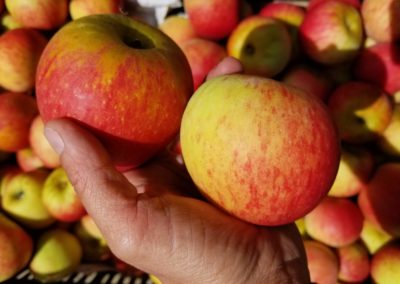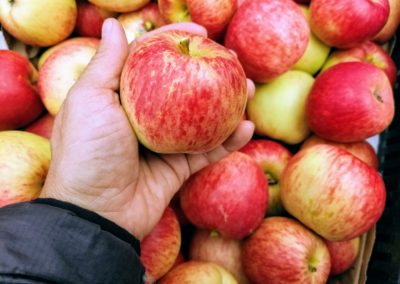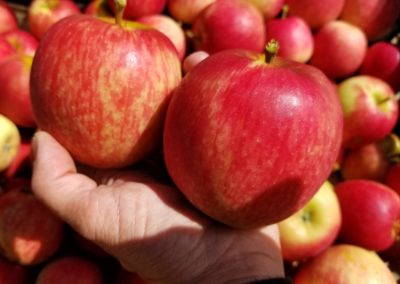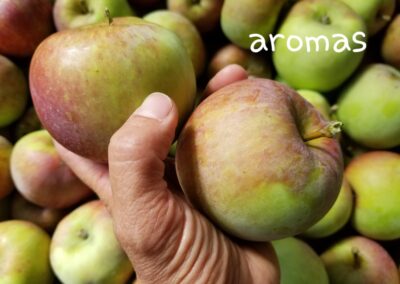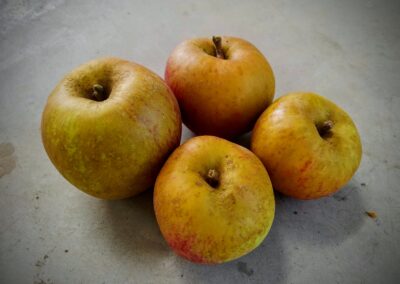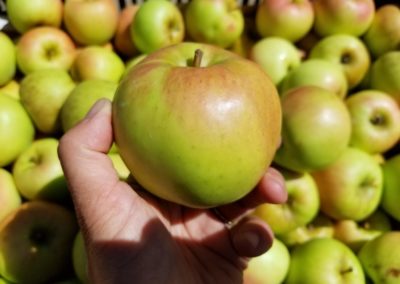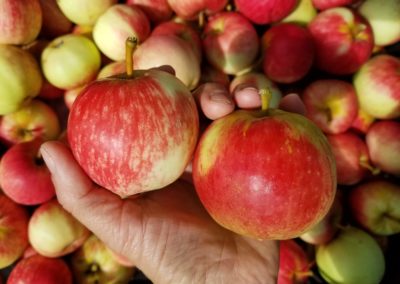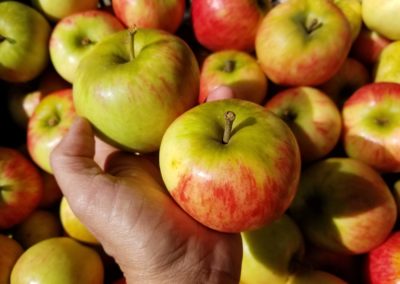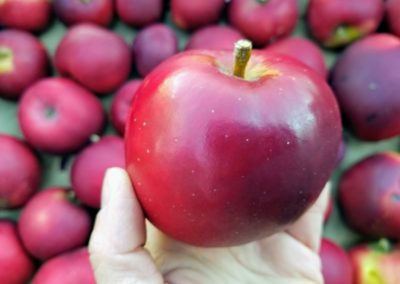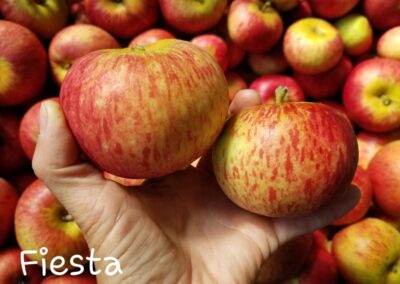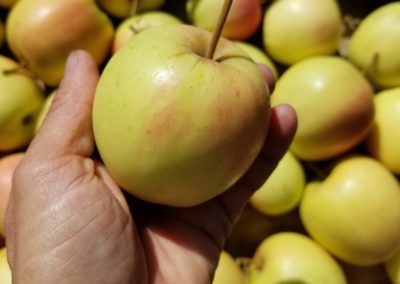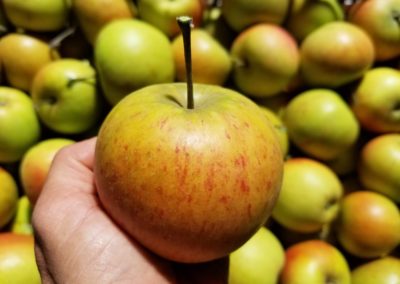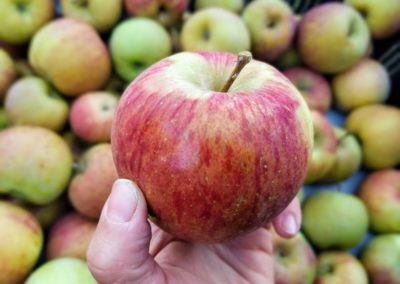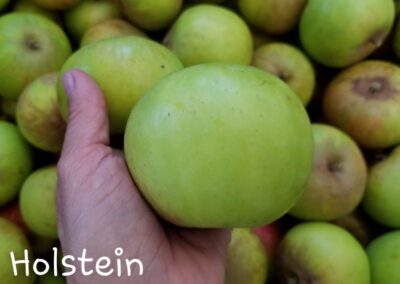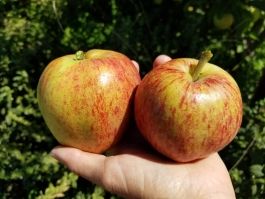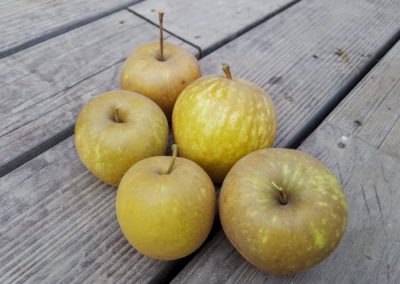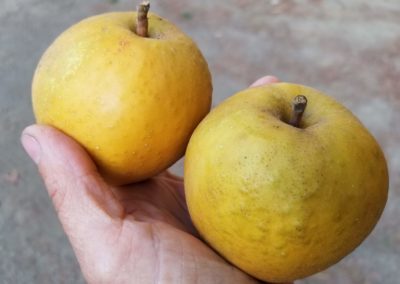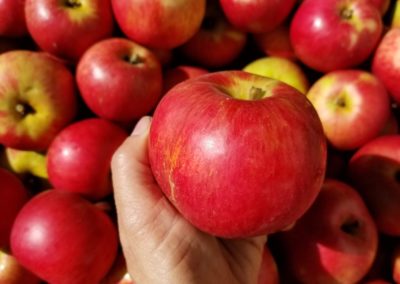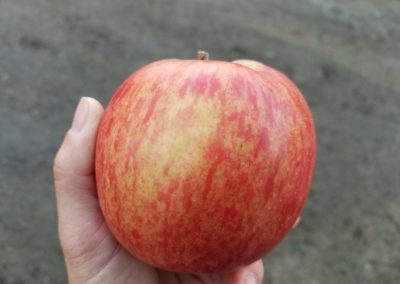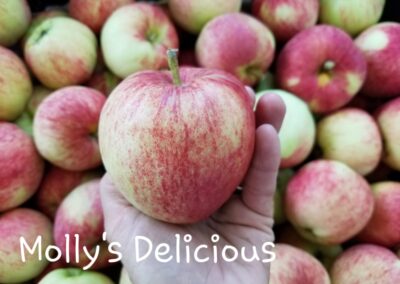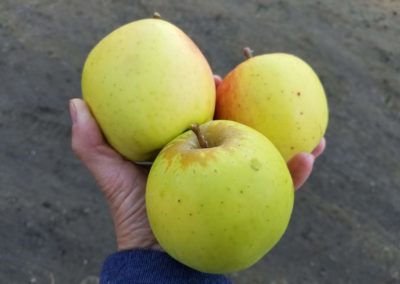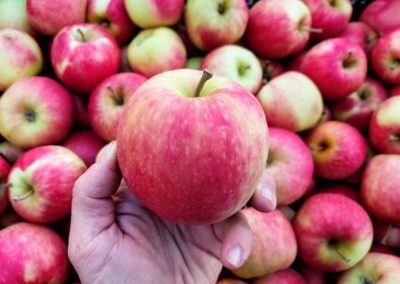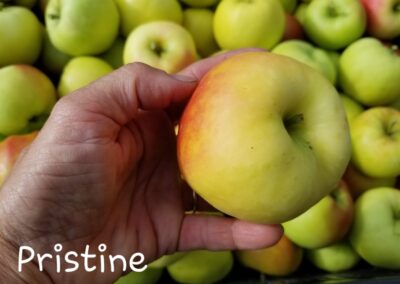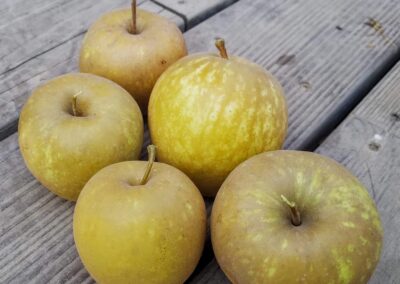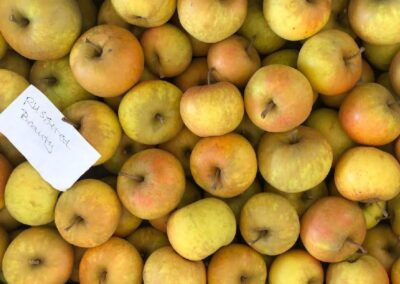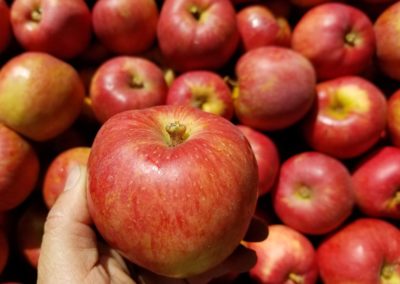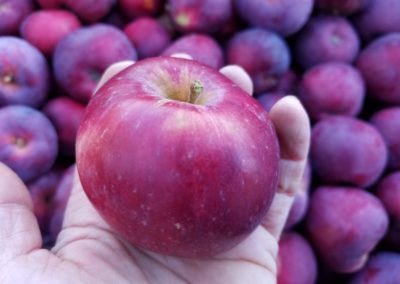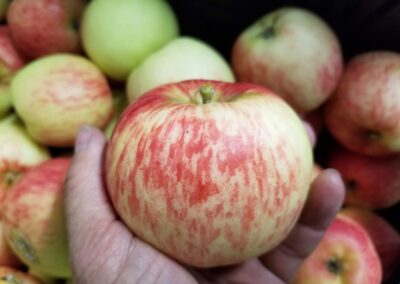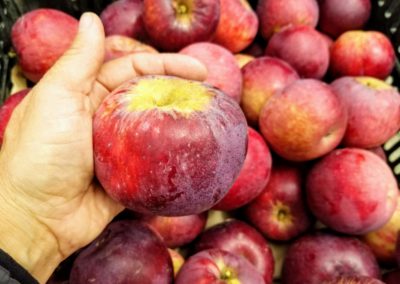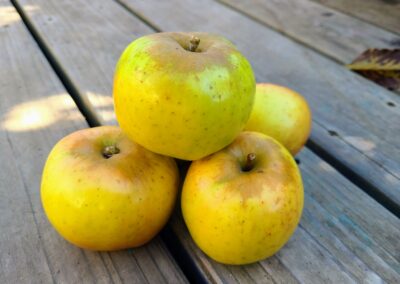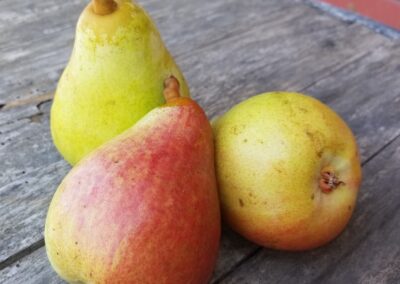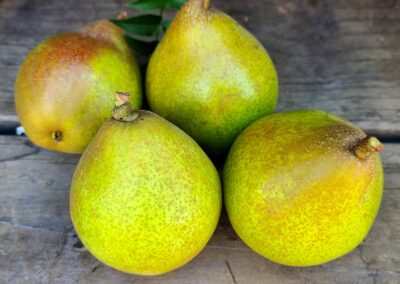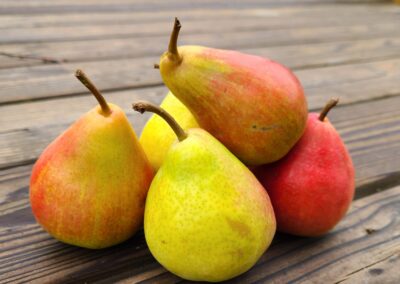Fifth Crow Specialty Apples and Pears
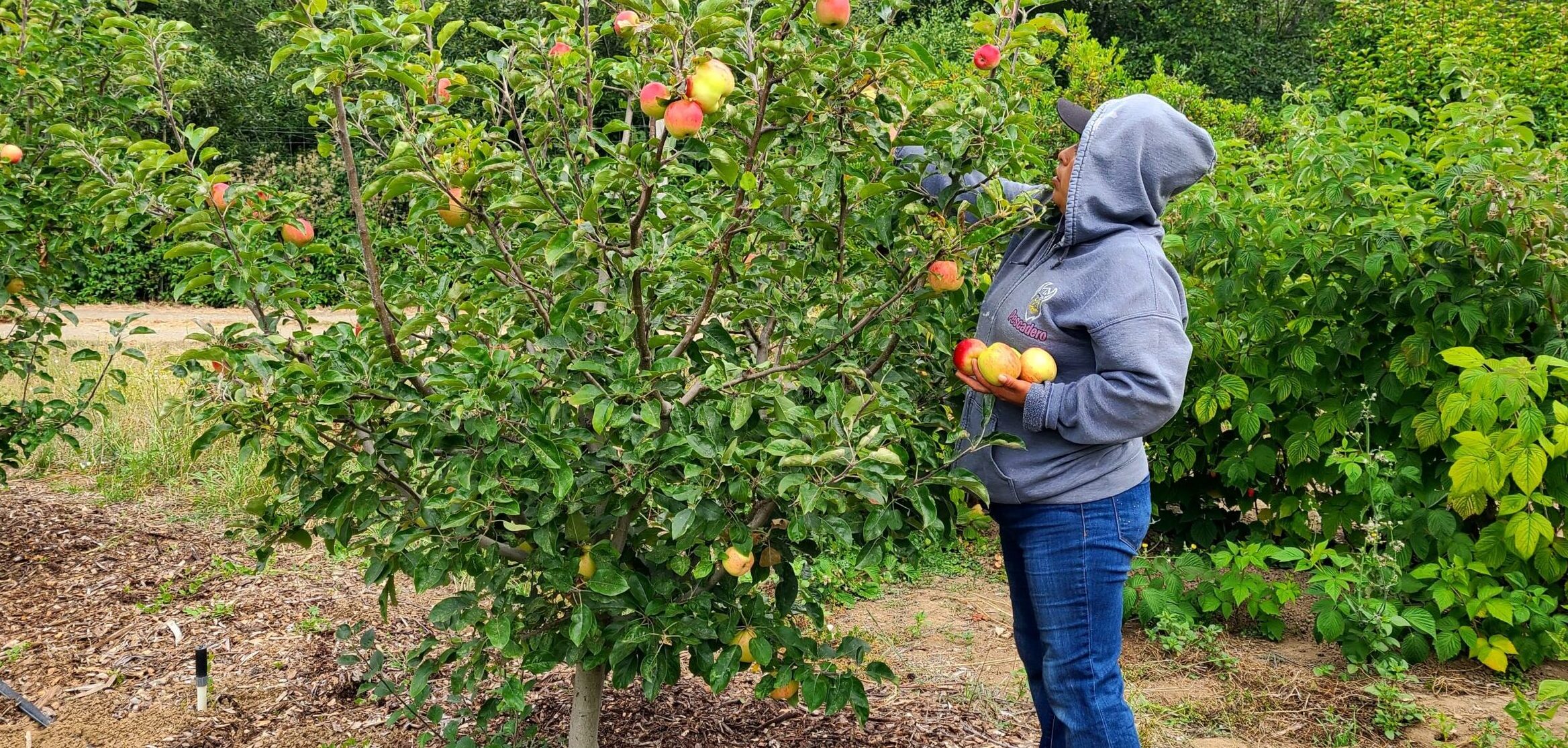
Our orchard began before Fifth Crow was even an idea…
John recruited Mike to help select and plant apple trees intended to be grown in Chehalis, WA on his grandpa’s farmland. They went to the apple master, Orin Martin, whom both John and Mike had studied under in the CASFS farm apprenticeship in Santa Cruz. Even though the trees were selected to grow in WA, they had all been grown in Santa Cruz and were suitable for the coastal climate. John and Mike hand grafted all the trees onto semi-dwarfing root stock and took them to the Esalen Institute in Big Sur where John was at that time managing the Esalen farm. The trees spent their first winter there before John, Mike, & Teresa decided to lease farmland here in Pescadero, which is now officially Fifth Crow Farm’s apple orchard.
How did we choose varieties?
The tree varieties were selected to provide amazing flavor, rather than high yield or commercial viability. We included both early and late producing varieties to extend our apple harvest season from mid-summer into late fall. From a business prospective we knew that farmers’ market customers would respond to uniqueness and flavor over your typical grocery store varieties. Fifth Crow has an unusual collection of apples that you’ll never see in a grocery store. Many of our apple trees are rare, heirloom, and heritage varieties.
We chose to graft the trees onto semi-dwarfing root stock to create a pedestrian orchard where you can pick the fruit standing on the ground without the use of ladders. This orchard style has benefits in efficiency of labor, but also can fit far more trees in per acre, allowing us to grow many more varieties than we could in a full sized orchard on our land. However, that means the individual trees have a lower yield, so smaller quantities will go to market at a time. When you find a variety you love savor it – we may only have it for a couple weeks!
How do we care for our orchard?
We do both a summer and a winter pruning, fertilize twice per year, regularly weed and mulch around the trees, and irrigate throughout the summer months. For pest management, we use pheromone traps to confuse coddling moths, and Tanglefoot once a year which is a sticky compound that is applied around the lower foot of the tree trunk to create a barrier for crawling insects. We do not use any sprays. The biggest pest pressure in our orchard are the birds.
Our apple varieties
Alkemene
Floral, lively, honeyed, mutation of Cox’s Orange Pippin from Germany. Sooo sweet, but nice tartness as well. One of farmer Mike’s favorite apples.
Arkansas Charm
Eat em quick, these delicious aromatic, sweet apples aren’t long storers.. cream flesh, red skin, slight pink color to flesh close to skin. Sweet over tart. Great early apple for eating out of hand
Arlet
Golden delicious & Idared cross. Intense complex flavor, sweet, spicy undertone. Aromatic, good for cooking.
Aroma
Hailing from Sweden where it is quite popular. A good balance of sweet & sour. Medium firm flesh.
Belle de Boskoop
Gold with a red blush, medium to heavily russeted. Creamy white dense flesh with a crisp texture. Layers of flavor. Tart, dry and highly aromatic mellows and sweetens with storage. Gets soft with cooking. Tend to be quite large.
Chehalis
Hailing from Chehalis, Washington, lovely yellow skinned apple. Crisp, sweet, juicy, a bit tart. Great fresh eating apple.
Corail
White juicy flesh. Crisp, rich, aromatic, sweet.. Also know as pinata, sonata, and pinova. Cox’s Orange Pippin, Golden Delicious, Dutchess of Oldenburg parentage.
Elstar
This apple can be slightly russeted (has skin that can be rough in spots like a pear or russet potato). It’s creamy white flesh has a balanced sweet/tart flavor with honey undertones and a mild acidity. Good for cooking. Makes a great applesauce. Flavor gets better after a few weeks in the fridge, so don’t worry if you don’t want to eat them right.
Enterprise
Dark red skin that could almost be described as black, white flesh ((think Snow White), firm texture. Great for cooking. Sweet, spicy, with mild tartness. Good keeper.
Fiesta
Sometimes marketed as a “Red Pippin”, this apple is often described as nutty and aromatic. Great dessert apple, good for juice and hard cider. Can often have a slight russeting (rough skin like a russet potato). Yellow skin with orange to red striping. Good keeper.
Golden Delicious
As Orin Martin our mentor from UCSC’s Farm & Garden would say “Golden Delicious is neither golden nor delicious after 5 months in storage. But fresh off the tree…” well, it’s a whole other thing. You might not even recognize it. Glowing yellow with the occasional pink blush. An old standby looks and tastes leaps and bounds better than it’s commercial counterpart which has often been stored for months prior to arriving at a store near you. The foundation of many popular apples.
Gravenstein
A great heirloom apple with good name recognition with customers. Great for cooking. Holds up well to baking.
Grimes Golden
This old variety is of American origin and thought to be the parent of Golden Delicious. Long stems, tendency to have slight russeting (rough skin). Crisp tender, spicy, sweet flavor.S More on the acidic side making it popular for hard cider and brandy.
Hokuto
Notoriously large apple. A cross between a Fuji and a Mutsu. From Japan, these very large, juicy, sweet, crisp apples are famous for their size- in 2005 a Hokuto claimed the World’s record for heaviest apple.
Holstein
Native to Germany, Holstein is a multi-use apple known for its highly aromatic and dense flesh. They are equally sweet and acidic, with notes of pineapple, citrus, and a hint of spice.
Honeycrisp
This lovely crisp, juicy variety has started to show up more and more at local stores so you are likely a bit familiar with it. Green with red striping, white flesh with honey overtones. Yum!
Hoople’sAntiqueGold
Originally discovered on a limb of a Golden Delicious on the Hoople’s Fruit Farm in Ohio. The name refers to the golden russeting. It’s medium to large fruit is aromatic, juicy, sweet and often one of the top rated apples at tastings.
Hudson’s Golden Gem
One of the few remaining truly fully russetted apples. Sugary sweet, crisp, yet with a distinctly pear-like flavor and texture. One of Teresa’s favorites. Beautiful bronze russeted apple (that means the skin is rough like a Bosc Pear). Many russet varieties of apples have disappeared from grocery stores, supposedly because of customer preference for shiny smooth apples. We think it’s time to bring them back! This variety is one of the sweetest of the russets we grow. Pear? Apple? It has a nutty pear-like texture & sugary sweetness.
Idared
Cross between a Jonathan and Wagener Apple. Originally from Moscow, ID. This beautiful dark red skinned apple holds up beautifully to cooking and keeps well. Mild flavor, can make a beautiful pink applesauce if cooked with skins. Sweetly tart.
Jonagold
Golden Delicious and Jonathan cross. We have 2 sets of trees we thought were Jonagolds.. but they’re now clearly not the same thing. These trees have more red blush, a sweet over tart flavor. Great dessert eating apple and make a great pie.
Molly’s Delicious
Red delicious parentage, sweet over tart, juicy & crisp. fabulous for eating out of hand.
Mutsu
From Japan (also known as ‘Crispin’). Golden Delicious & Indo parentage. Green, ripening to yellow with a copper blush. Incredibly crisp, juicy, firm and a bit more tart than Golden Delicious. Makes a great dessert apple. A HUGE monstrosity of an apple that leads to lots of bragging rights between growers. I swear we have one this year that is nearly the size of my toddler’s head. Some claim hints of anise. It sweetens further in storage and is great for cider. Non-browning when cut. Fabulous apple for eating out of hand.
Pink Lady
Sweet and tangy with a nice blush colored skin. A cross between a Golden Delicious and a Lady Williams. This variety is our last variety to harvest and the longest to store. While a relatively recent apple it has gained recognition for good reason. It’s a great apple!
Pristine
Glowing yellow skinned apple that is crisp, juicy, sweet-tart and usually the first one to ripen for the season. Similar to a Yellow Transparent.
Roxbury Russet
Thought to be one of the oldest varieties of apples grown in the United States dating back to early settler times. Some acidity, but fundamentally a sweet apple. Firm texture, good keeper. Variably russeted skin.
Russet Beauty
Delicious baked in a pie. This russeted apple tends towards a soft texture, and has an unusual (and addictive) flavor- a citrus-like tart flavor over it’s sugary sweetness.
Spartan
The Spartan apple gets its name from its resilience in various weather types. It has an almost black skin and soft pure white flesh. Think “Snow White”. Originated in Canada. Sweet and juicy.
Sunrise
Yellow background, red stripes. Good sweet/start balance. sweeter over tart compared to the Pristine. White flesh, juicy.
William’s Pride
Dark Red apple that is one of our earliest ripening varieties. Cream colored flesh. Complex, sweet, some say hints of pear.
Pear Varieties
Seckel
Sugar lumps! These tiny pears are sugary sweet reminiscent of a canned pear. A favorite with our kids, they’re fabul
Ubileen
Hailing from either Bulgaria or Yugoslavia depending on where you read, this extremely early pear tops the chart in taste tests. It has a buttery texture, is sweet, juicy, with just the right amount of tartness. The trick is picking it and eating it at the right time.
Bosc
These elegant, unique russeted pears are known for their complex, honey-like flavor. Firm flesh makes them a great choice for baking and cooking applications. This variety dates back to the early 1800’s in Belgium and France.


